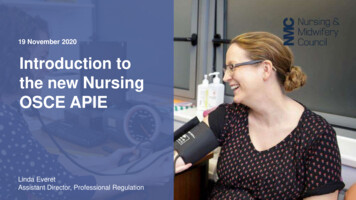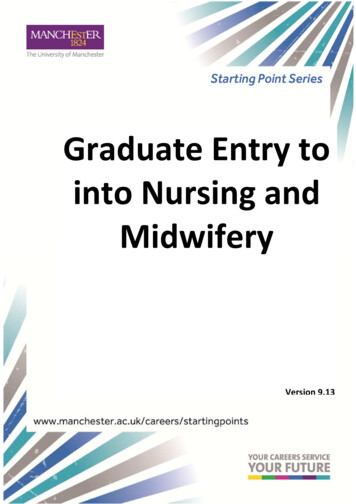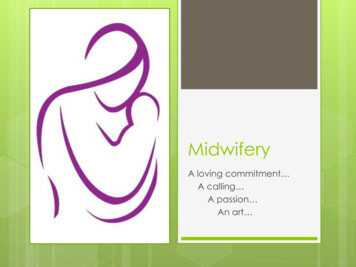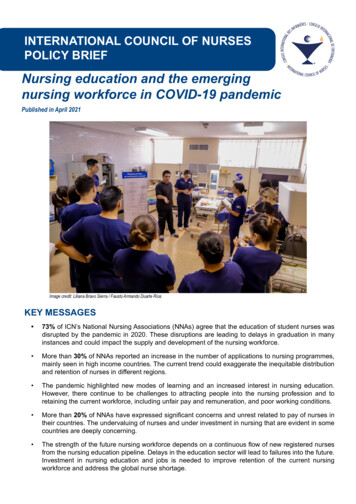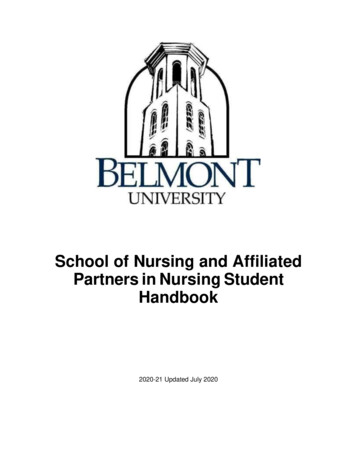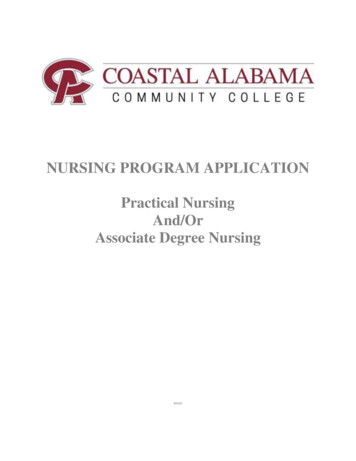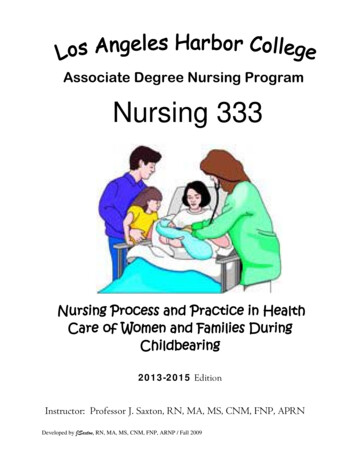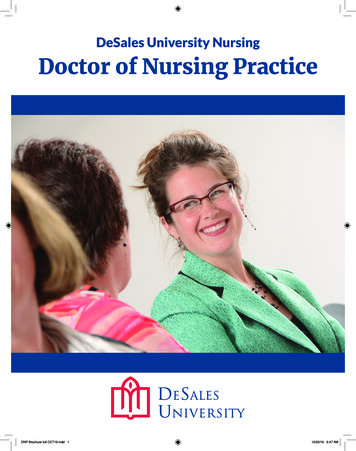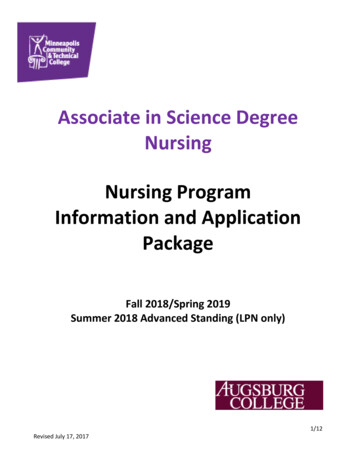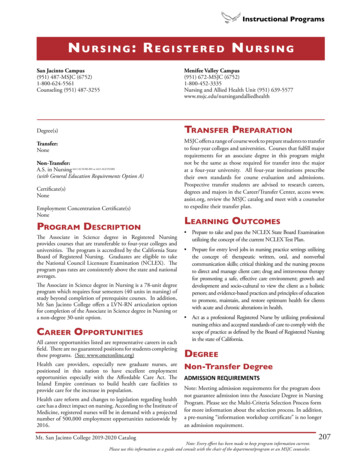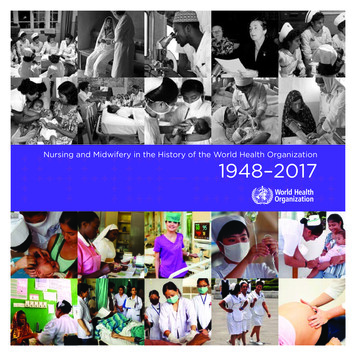
Transcription
Nursing and Midwifery in the History of the World Health Organization1948–2017
Nursing and Midwifery in the History of the World Health Organization1948–2017
Nursing and midwifery in the history of the World Health Organization 1948-2017ISBN 978-92-4-151190-2 World Health Organization 2017Some rights reserved. This work is available under the Creative Commons Attribution-NonCommercial-ShareAlike 3.0 IGO licence (CC BY-NC-SA 3.0 IGO; igo).Under the terms of this licence, you may copy, redistribute and adapt the work for non-commercial purposes, provided the work is appropriately cited, as indicated below. In any use of this work, there shouldbe no suggestion that WHO endorses any specific organization, products or services. The use of the WHO logo is not permitted. If you adapt the work, then you must license your work under the same orequivalent Creative Commons licence. If you create a translation of this work, you should add the following disclaimer along with the suggested citation: “This translation was not created by the World HealthOrganization (WHO). WHO is not responsible for the content or accuracy of this translation. The original English edition shall be the binding and authentic edition”.Any mediation relating to disputes arising under the licence shall be conducted in accordance with the mediation rules of the World Intellectual Property Organization.Suggested citation. Nursing and Midwifery in the History of the World Health Organization 1948-2017. Geneva: World Health Organization; 2017. Licence: CC BY-NC-SA 3.0 IGO.Cataloguing-in-Publication (CIP) data. CIP data are available at http://apps.who.int/iris.Sales, rights and licensing. To purchase WHO publications, see http://apps.who.int/bookorders. To submit requests for commercial use and queries on rights and licensing, see http://www.who.int/about/licensing.Third-party materials. If you wish to reuse material from this work that is attributed to a third party, such as tables, figures or images, it is your responsibility to determine whether permission is needed forthat reuse and to obtain permission from the copyright holder. The risk of claims resulting from infringement of any third-party-owned component in the work rests solely with the user.General disclaimers. The designations employed and the presentation of the material in this publication do not imply the expression of any opinion whatsoever on the part of WHO concerning the legalstatus of any country, territory, city or area or of its authorities, or concerning the delimitation of its frontiers or boundaries. Dotted and dashed lines on maps represent approximate border lines for whichthere may not yet be full agreement.The mention of specific companies or of certain manufacturers’ products does not imply that they are endorsed or recommended by WHO in preference to others of a similar nature that are not mentioned.Errors and omissions excepted, the names of proprietary products are distinguished by initial capital letters.All reasonable precautions have been taken by WHO to verify the information contained in this publication. However, the published material is being distributed without warranty of any kind, either expressedor implied. The responsibility for the interpretation and use of the material lies with the reader. In no event shall WHO be liable for damages arising from its useDesign and layout by L’IV Com Sàrl, Villars-sous-Yens, Switzerland.Printed in France.
Foreword . . . . . . . . . . . . . . . . . . . . . . . . . . . . . . . . . . . . . . . . . . . . . . . . . . . . . . . . . . . . . . viAcknowledgements . . . . . . . . . . . . . . . . . . . . . . . . . . . . . . . . . . . . . . . . . . . . . . . . . viiExecutive Summary . . . . . . . . . . . . . . . . . . . . . . . . . . . . . . . . . . . . . . . . . . . . . . . . . . ixBackground . . . . . . . . . . . . . . . . . . . . . . . . . . . . . . . . . . . . . . . . . . . . . . . . . . . . . . . . . . . . xiIntroduction. . . . . . . . . . . . . . . . . . . . . . . . . . . . . . . . . . . . . . . . . . . . . . . . . . . . . . . . . . . xiiEarly decades (1948–1973). . . . . . . . . . . . . . . . . . . . . . . . . . . . . . . . . . . . . . . . .Setting priorities . . . . . . . . . . . . . . . . . . . . . . . . . . . . . . . . . . . . . . . . . . . . . . . . . . . . . . . . . . .Organizing the structure for nursing in WHO . . . . . . . . . . . . . . . . . . . . . . . . .An Expert Committee on Nursing is established . . . . . . . . . . . . . . . . . . . . .Increased WHO nursing and midwifery capacity impacts countries .PART INursing in the workplan . . . . . . . . . . . . . . . . . . . . . . . . . . . . . . . . . . .The need for professional and technical education .WHO fellowship programme . . . . . . . . . . . . . . . . . . . . . . . .Finding the funds . . . . . . . . . . . . . . . . . . . . . . . . . . . . . . . . . . .Stressing the need to train more nurses . . . . . . . . . . . . .Finding the teachers to train the nurses . . . . . . . . . . . . .Setting up training in newly independent countries .Defining the role of nursing and midwifery . . . . . . . .The Second Expert Committee on Nursing . .Giving more prominence to midwifery . . . . . .The nurse of tomorrow (as foreseen in 1966). . . . . . . . . . . . . . . . . . . . . . . . . . . . . . . . . . . . . . . . . . . . . . . . . . . . . . . . . . . . . . . . . . . . . . . . . . . . . . . . . . . . . . . . . . . . . . . . . . . . . . . . . . . . . . . . .233455666778. 8. 911. . . . . . . . . . . . . . . . . . . . . . . . . . . . . . . . . . . . . . . . . . . . . . . . . . . . . . . . . . . . . . . . . . . . . . . . . . . . . . . . . . . . . . . . . . . . . .Strengthening nursing and midwifery education and training . . . . . .Collaboration between stakeholders . . . . . . . . . . . . . . . . . . . . . . . .Other sources of technical advice for nursing and midwiferyin WHO . . . . . . . . . . . . . . . . . . . . . . . . . . . . . . . . . . . . . . . . . . . . . . . . . . . . . .Attracting new students of nursing . . . . . . . . . . . . . . . . . . . . . . . . . . .The important role of chief nursing and midwifery officers . . . .Preparing teachers . . . . . . . . . . . . . . . . . . . . . . . . . . . . . . . . . . . . . . . . . .Public health nursing in rural health services. . . . . . . . . . . . . . . . . .Improving practice sites for teaching . . . . . . . . . . . . . . . . . . . . . . . .Redefining nursing curricula . . . . . . . . . . . . . . . . . . . . . . . . . . . . . . . . .The challenge to unify standards . . . . . . . . . . . . . . . . . . . . . . . . . . . .Promoting research.1. . . . . . . . . . . . .1212. . . . . . .1214141515161617. . . . . . . . . . . . . . . . . . . . . . . . . . . . . . . . . . . . . . . . . . . . . . . . . . . . . .18Advocacy and partnerships . . . . . . . . . . . . . . . . . . . . . . . . . . . . . . . . . . . . . . . . . . . . . . . . . . . . . . . . . . . . . . . . . . . . . . . . . . . . . . . . . . . . . . .20iii
Primary health care (1974–2000) . . . . . . . . . . . . . . . . . . . . . . . . . . . . . . . . 23PART IIA new approach shows the need for new personnel . . . . . . . . . .Promoting the development of new health services . . . . .Primary health care dependent on nurses and midwivesDeveloping health manpower to meet new challenges .The leadership role in primary health care . . . . . . . . . . . . . . .Nurses assume leadership in health teams . . . . . . . . . . . . . . .Persisting challenges. . . . . . . . . . . . . . . . . . . . . . . . . . . . . . . . . . . . .A clearer vision of nursing and midwifery. . . . . . . . . . . . . . . . . . . . . .WHO headquarters establishes a nursing unit . . . . . . . . . . .The Global Advisory Group on Nursing and Midwifery . . .The first Meeting of the Global Advisory Group onNursing and Midwifery . . . . . . . . . . . . . . . . . . . . . . . . . . . . . . . . . .Developing nursing and midwifery leadership. . . . . . . . . . .WHO Collaborating Centres for Nursing and MidwiferyDevelopment . . . . . . . . . . . . . . . . . . . . . . . . . . . . . . . . . . . . . . . . . .Capacity-building for nursing and midwifery leadershipin Africa . . . . . . . . . . . . . . . . . . . . . . . . . . . . . . . . . . . . . . . . . . . . . . . .Capacity-building for nursing and midwifery leadershipin Europe . . . . . . . . . . . . . . . . . . . . . . . . . . . . . . . . . . . . . . . . . . . . . . .Capacity-building for nursing and midwifery leadershipin Western Pacific . . . . . . . . . . . . . . . . . . . . . . . . . . . . . . . . . . . . . . .Reorienting education and training to support primaryhealth care . . . . . . . . . . . . . . . . . . . . . . . . . . . . . . . . . . . . . . . . . . . . .Expanding the roles of nurses and midwives . . . . . . . . . . . . . . . . . .Family health . . . . . . . . . . . . . . . . . . . . . . . . . . . . . . . . . . . . . . . . . . .HIV/AIDS. . . . . . . . . . . . . . . . . . . . . . . . . . . . . . . . . . . . . . . . . . . . . . . .Home-based care . . . . . . . . . . . . . . . . . . . . . . . . . . . . . . . . . . . . . .Malaria control . . . . . . . . . . . . . . . . . . . . . . . . . . . . . . . . . . . . . . . . .Emerging and reemerging infectious diseases andantimicrobial resistance . . . . . . . . . . . . . . . . . . . . . . . . . . . . . . . .The need for further research on nursing and midwifery . . . . . . . . . . . . . . . . . . . . . . . . . . . . . . . . . . . . . . . . . . . . . . . . . . . . . . . . . . . . . . . . . . . . . . . . . . . . . . . . . . . . . . . . . . . . . . . . . . . . . . . .303030. . . . . . . . . . . .3134. . . . . . . . . . . .35. . . . . . . . . . . .36. . . . . . . . . . . .36. . . . . . . . . . . .37. . . . . . . . . . . .38. . . . . . . . . . . .4142434343. . . . . . . . . . . . . . . . . . . . . . . . . . . . . . . . . . . . . . . . . . . . . . . . . . . . . . . . . . . . . . . . . . . . . . . . . . . . . .Laying a new legal foundation for the nursing andmidwifery professions . . . . . . . . . . . . . . . . . . . . . . . . . . . . . . . . . . . . . . . . . . .Building a new regulatory system for nurses and midwivesiv23242526282828. . . . . . . . . . . . . . . . . . .44444748
More recent developments (2000–present) . . . . . . . . . . . . . . . . 53PART IIIFrom the Millennium Development Goals to the SustainableDevelopment Goals . . . . . . . . . . . . . . . . . . . . . . . . . . . . . . . . . . . . . . . .Increasing attention to the health workforce discourse . . . .A strategic vision for the new century . . . . . . . . . . . . . . . . . . .Leadership and governance roles for nurses and midwives .Updating and upgrading education and training . . . . . . . . .Need for evidence for HRH Development . . . . . . . . . . . . . . . .Improving service delivery . . . . . . . . . . . . .Providers of essential care . . . . . . . .Maternal and child health . . . . . . . .Emergencies and disaster response. . . . . . . . . . . . . . . . . . . . . . . . . . . . . . . . . . . . . . . . . . . . . . . . . . . . . . . . . . . . . . . . . . . . . . . . . . . . . . . . . . . . . . . . . . . . . . . . . . . . . . . . . . . . . . . . . . . . . . . . . . . . . . . . . . . . . . . . . . . . . . . . .53545556586061626263WHO’s Global strategic directions for strengtheningnursing and midwifery 2016–2020 . . . . . . . . . . . . . . . . . . . . . . . . . . 66Setting the scene for nursing and midwifery development . . . . . . . . . . . . .65PART IVConclusions . . . . . . . . . . . . . . . . . . . . . . . . . . . . . . . . . . . . . . . . . . . . . . . . . . . 75Perspectives on the future of nursing and midwifery. . . . . . . 77Annexes . . . . . . . . . . . . . . . . . . . . . . . . . . . . . . . . . . . . . . . . . . . . . . . . . . . . . . . 81Annex 1. List of participants, Meeting on the History of Nursingand Midwifery . . . . . . . . . . . . . . . . . . . . . . . . . . . . . . . . . . . . . . . . . .Annex 2. World Health Assembly (1949–2015) Resolutionson nursing and midwifery . . . . . . . . . . . . . . . . . . . . . . . . . . . . . . . . . . . . . . . . .81. . . . . . . . . .85v
Nursing and Midwifery in the History of the World Health Organization1948–2017FOREWORDEvery country needs a competent, motivated, well-distributed and supported health workforce.Health workers are the cornerstone of the strong, resilient health systems needed to achieveuniversal health coverage. These are the people who keep the world safe, improve health, andprotect the vulnerable.These are the people who detect, prevent and manage health emergencies, and who promote thewell-being of women, children and adolescents.Nurses and midwives are the unsung heroes of the health workforce and the backbone of primaryhealth care systems. Making up over half of the health workforce in many countries, nurses andmidwives can transform the ways health actions are organized and how health care is delivered.Dr Tedros Adhanom GhebreyesusDirector-GeneralWorld Health OrganizationOver the years, nurses and midwives have contributed to major global health landmarks, like theeradication of small pox and the dramatic reductions in maternal and child mortality that haveoccurred in many countries. But nurses and midwives need support and they need recognition.This report on the history of nursing and midwifery in the World Health Organization celebratesthe work of these core health workers. It provides a vivid account of the contributions they havemade to strengthening global health systems. It shows how WHO has endeavoured to give thema voice over several decades, and highlights the critical role they will play in improving healthoutcomes in the coming years as the world strives to meet the Sustainable Development Goals.vi
Nursing and Midwifery in the History of the World Health Organization1948–2017ACKNOWLEDGEMENTSThis work could not have been accomplished without the commitment and contributions of a number of persons. The WorldHealth Organization wishes to acknowledge the efforts of the group of individuals who provided technical input to the initialoutline: Fariba Al-Darazi, Former Regional Adviser for Nursing and Midwifery, World Health Organization Regional Office forthe Eastern Mediterranean; Naeema Al Gasseer (Former Senior Scientist for Nursing and Midwifery, World Health Organization,Switzerland), WHO Representative in Sudan; Tomas Allen, Library and Information Networks for Knowledge, World HealthOrganization, Switzerland; Jing Wang Cavallanti, Technical Officer, Global Health Histories, WHO Press, World HealthOrganization, Switzerland; Patricia D’Antonio, Chair, Department of Family and Community Health, University of PennsylvaniaSchool of Nursing, Philadelphia (PA), USA; Jennifer Dohrn, Director, Office of Global Initiatives and WHO CollaboratingCenter for Advanced Practice Nursing, Columbia University, New York (NY), USA; Stephanie Ferguson, International HealthCare Consultant, Amherst (VA), USA; Kathleen Fritsch (Former World Health Organization Regional Adviser for Nursing andMidwifery, World Health Organization Western Pacific Region), School of Nursing and Dental Hygiene, University of Hawaii atManoa, Honolulu (HI), USA; Sandra Land (Former Regional Adviser for Nursing and Midwifery, World Health OrganizationRegional Office for the Americas); Ilta Lange, Former Regional Adviser for Nursing and Midwifery, World Health OrganizationRegional Office for the Americas; Silvina Malvarez (Former Regional Advisor for Nursing and Health Personnel Development,World Health Organization Regional Office for the Americas), School of Public Health, National University of Cordoba, Argentina;Gugu Mchunu, Head, School of Nursing and Public Health, University of KwaZulu-Natal, South Africa; Isabel Amélia CostaMendes, (Former Director, World Health Organization, Collaborating Centre for Nursing Research Development, College ofNursing at Ribeirão Preto, University of São Paulo, Brazil; Ntombifikile Mtshali, School of Nursing and Public Health, Universityof KwaZulu-Natal, South Africa; Busisiwe Ncama, Director/Dean and Head of School, World Health Organization CollaboratingCentre for Nursing and Midwifery, School of Nursing and Public Health, University of KwaZulu-Natal, South Africa; NthabiPhaladze, Assistant Director, World Health Organization Collaborating Centre for Nursing and Midwifery Development, Universityof Botswana; Duangvadee Sungkhobol (Former Regional Adviser for Nursing and Midwifery, World Health Organization RegionalOffice for South-East Asia), Consultant, Human Resources for Health, Medical Council of Thailand and Lis Wagner (FormerRegional Adviser for Nursing and Midwifery, World Health Organization Regional Office for Europe), Professor, University ofSouthern Denmark, Odense, Denmark.The project was conceived and coordinated by Annette Mwansa Nkowane, Technical Officer, Health Workforce Departmentwith support from Jim Campbell, Director, Health Workforce Department, World Health Organization, Switzerland. Technicalsupport provided by Onyema Ajuebor, Technical Officer, Health Workforce Department. Administrative support was provided byBeatrice Wamutitu.vii
Nursing and Midwifery in the History of the World Health Organization1948–2017The draft was prepared by Socrates Litsios.Revision and editing of the draft were carried out by David Bramley.The following are acknowledged for their perspectives on the future of nursing and midwifery in the World Health Organization:Rita Carty, Former Secretary General of the Global Network of World Health Organization Collaborating Centres for Nursingand Midwifery Development; Eric Chan, Former Coordinator, Health Profession, Nursing and Midwifery, Department of HumanResources and Health, World Health Organization, Switzerland; Miriam Hirschfeld, Former Chief Nursing Scientist, WorldHealth Organization, Switzerland; Sue Kim, Director, World Health Organization Collaborating Center for Research and Trainingfor Nursing Development in Primary Health Care, Yonsei University College of Nursing, Republic of Korea; Linda McCreary,Co-Director, World Health Organization Collaborating Centre for International Nursing Development in Primary Health Care,University of Illinois at Chicago (UIC) College of Nursing, Chicago (IL), USA; Theresa Rope Elizabeth Miller, Former RegionalNurse Advisor, World Health Organization Western Pacific Region; Judith Oulton, Former Chief Executive Officer, InternationalCouncil for Nurses and Michelle Rumsey, Director, World Health Organization Collaborating Center for Nursing, Midwifery andHealth Development, Faculty of Health, University of Technology, Sydney, Australia .The following persons are acknowledged for their contributions to the photographs: Onyema Ajuebor, Technical Officer, HealthWorkforce Department, World Health Organization, Switzerland; Love Odetola and Su Yu-Yin (former interns at the WorldHealth Organization, Switzerland); Reynald Erard, Information Officer, Records and Archives, World Health Organization, SabatiniChoquard Laetizia, Records and Archives Intern, World Health Organization and Lindsey Williams, International Council ofNurses, Switzerland.viii
Nursing and Midwifery in the History of the World Health Organization1948–2017EXECUTIVE SUMMARYSince the founding of the World Health Organization (WHO) in 1948, nursing and midwifery development has maintained adistinguished status within the human resources for health programme of the Organization. This report documents the progressmade by using chronological and thematic approaches to chart the key historical timelines and events that have shaped thenursing and midwifery policy discourse through the decades. It also examines available strategic opportunities to build effectiveprogrammes that will ensure a socially responsible and fi
A strategic vision for the new century. 55 Leadership and governance roles for nurses and midwives. 56 Updating and upgrading education and . University of Illinois at Chicago (UIC) College of Nursing, Chicago (IL), USA; Theresa Rope Elizabeth Miller, Former Regional and Nursing and Midwifery in the History of the World Health .
